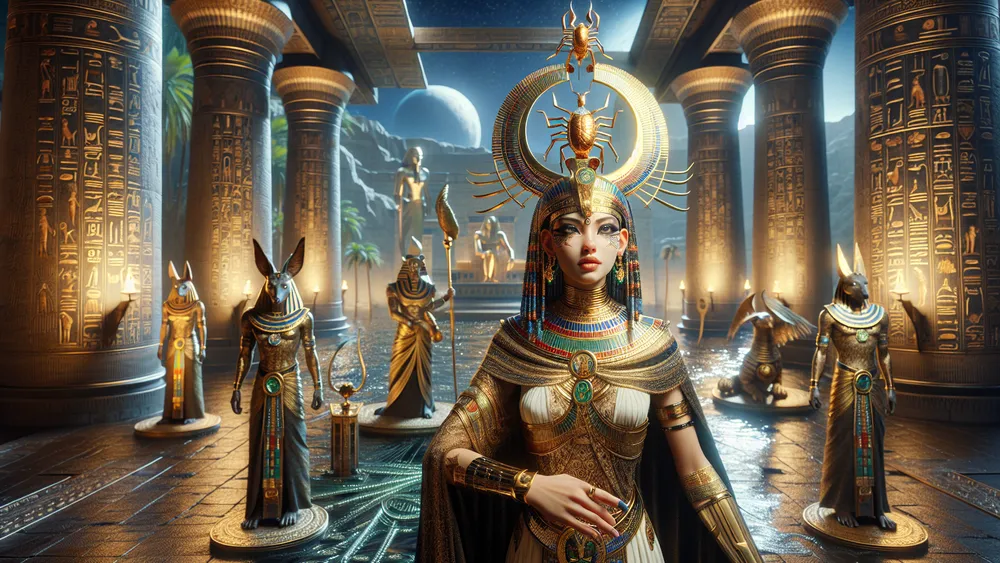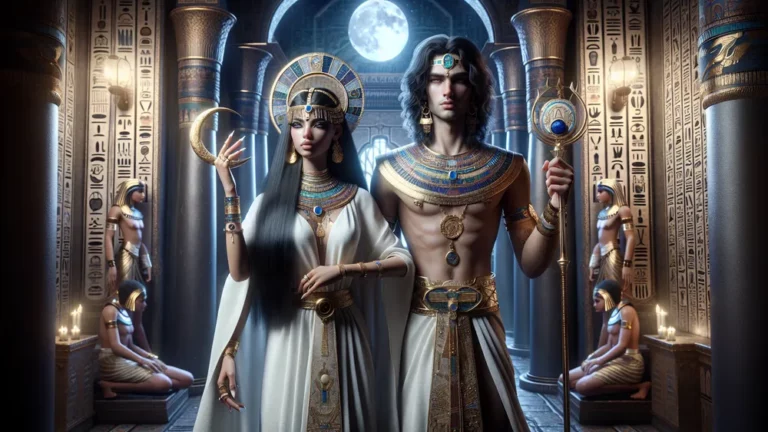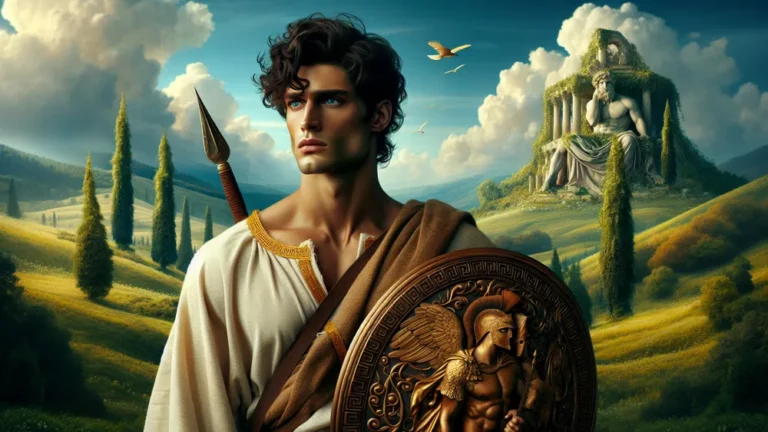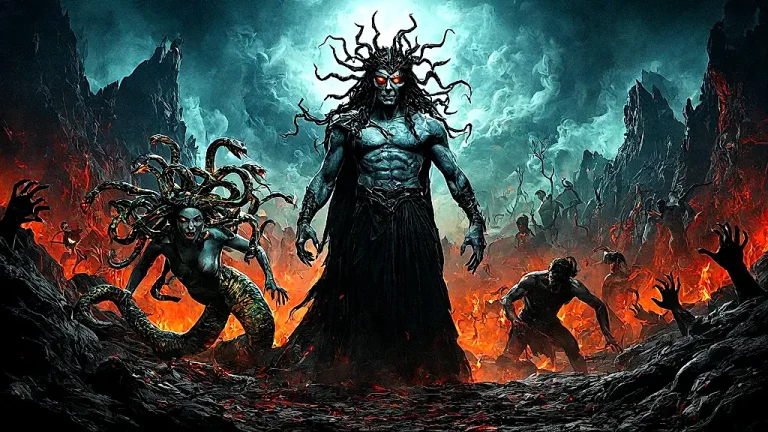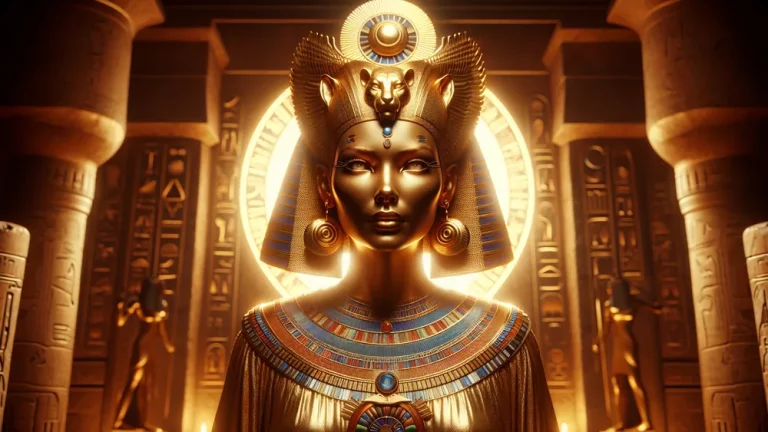Scorpions In Egyptian Mythology: Key Deities And Symbols
Welcome to our look at scorpions in Egyptian myths, an interesting trip into the past times where these mysterious animals had big symbolic power. Much like fire which can warm and also burn, scorpions in ancient Egypt were seen as two-sided creatures – able to protect and hurt. In this blog, you will see the different parts scorpions had in old Egypt beliefs, from ideas to pictures in writings.
Key Points:
- Scorpions in ancient Egypt symbolized both protection and danger, representing the duality of life and death.
- The goddess Serket was a key deity tied to scorpions, known for her healing and protective powers.
- Scorpions played a vital role in Egyptian art and writings, appearing in hieroglyphs, tomb paintings, and amulets.
- In Egyptian mythology, scorpions were linked to gods like Serket, Neith, and Nephthys, representing protection and danger.
- Scorpions were used in ancient Egyptian medicine for their healing properties, particularly their venom.
- Stories like Isis and her seven scorpions highlighted the protective and caring nature of scorpions in Egyptian culture.
- Today, scorpions remain a part of Egyptian culture, symbolizing strength and survival in modern media and art.
Also, we will look at gods tied with scorpions like Serket, the goddess who protects. Plus, the myth of Isis and the seven scorpions gets mentioned. And we will study scorpions in tomb writings, their use in old treatments, and how they are shown in traditional stories.
At the end of this post, you will get a full idea of the many sides of scorpions in old Egyptian culture and how they are still seen now.
Scorpions In Egyptian Mythology: Overview and Key Facts
| Key Point | Description |
|---|---|
| Symbols | Scorpions were seen as signs of both protection and danger, showing the two sides of life and death. |
| Gods | The most known god related to scorpions is Serket, the goddess of healing and protection. |
| Stories | Scorpions are important in myths like the story of Isis and her seven scorpions, showing how they protect. |
| Art | Scorpions appeared in many kinds of Egyptian art like hieroglyphs, amulets, and tomb paintings, often showing protection and power. |
| Tomb Writings | Scorpions also appear in tomb writings and spells, where they are called for protection in the afterlife. |
| Medicine | Scorpion venom was used in old Egyptian medicine for its believed healing properties, even though it can be dangerous. |
| Beliefs | Scorpions were both feared and respected, showing their complex role in Egyptian culture and ideas. |
| Today | Nowadays, scorpions still are part of Egyptian culture, seen in stories and modern media, keeping their old symbolic meanings. |
How Scorpions Fit into Ancient Egyptian Beliefs
If people want to understand the many-sided roles scorpions had in old Egyptian life, it’s important to look at their symbol ideas, art pictures, and links with different gods.
What Scorpions Represented in Ancient Egypt
In old Egyptian culture, scorpions had a complicated meaning, showing both safety and danger. Much like something that can be good and bad, they were respected for their ability to keep away evil, yet also feared for their poisonous sting. This mix can be seen in many areas of Egyptian myths and everyday life. For example, scorpions were often shown as guards in tombs and temples, showing their protective side. But, their poison was a reminder of possible danger. To help understand these symbol ideas better, here is a list of common symbols and their meanings related to scorpions:
- Protection: People saw scorpions as guards, often put in amulets and charms to keep away bad spirits.
- Danger: Their poison sting meant they could harm and kill, reminding people of how fragile life is.
- Healing: Even though they were dangerous, scorpions were also tied to healing, especially through the goddess Serket, believed to cure poisonous stings.
- Power: Scorpions stood for strength and toughness, qualities that people admired and wanted in old Egyptian society.
Scorpions in old Egyptian culture symbolized both protection and danger, representing the duality of good and bad aspects in life.
Scorpions in Egyptian Art and Writing
In old Egyptian pictures and writings, scorpions showed up in many ways, each carrying a big symbolic meaning. Hieroglyphs, those special picture-letters, often had scorpions to show protection and strength, while tomb art and good luck charms showed them as guards against bad stuff happening. For instance, they often carved scorpions into good luck charms worn by people and put with the dead to make sure of safety after death.
These pictures and carvings were not just for looking at but had deep religious and cultural meaning, showing the double nature of scorpions as both guards and threats. Here’s a table to show different artistic ways of showing scorpions:
| Artistic Representation | Description | Significance |
|---|---|---|
| Hieroglyphs | Scorpions were shown in hieroglyphs to show protection and strength. | Used in texts to call for protection and keep away bad things. |
| Tomb Paintings | Scorpions appeared in tomb paintings as protectors of the dead. | Showed protection in the life after death. |
| Amulets | Scorpions were carved into charms worn by the living and placed with the dead. | Acted as good luck charms against evil spirits. |
| Temple Carvings | Scorpions were shown in temple carvings, often linked with the goddess Serket. | Showed divine protection and healing. |
Gods and Goddesses Linked with Scorpions
To completely understand the importance of scorpions in Egyptian stories, it’s needed to check their links with many gods.
Serket: The Scorpion Goddess
Serket, who also has names like Selket and Selcis, is among the most well-known gods in old Egyptian stories, known as the scorpion goddess. She is sometimes shown as a woman with a scorpion on her head or as a scorpion with a woman’s head, showing she rules over these creatures.
Her name means “She Who Makes the Throat Breathe”, which points to her link with breath and life. She was believed to have the power to stop stings and bites that are poisonous, making her a key protective goddess.
Her role was not just about protection; she was also used in healing rituals and looked after the dead, making sure they got to the next life safely.
In stories, Serket’s protective and healing sides are shown clearly. People often called her to guard them from venomous animals and to heal stings or bites. This made her a loved and widely worshiped figure. In one story, for example, the tale of Isis and the seven scorpions, Serket helps Isis protect her son, Horus, from harm. This story shows Serket’s protective side and her willingness to help others, both gods and humans. Here are some well-known stories and myths about Serket:
- The Story of Isis and the Seven Scorpions: Serket helps Isis protect her son, Horus, from danger.
- Funerary Texts: Serket is called upon in spells and texts to guard the dead on their way to the afterlife.
- Healing Rituals: Serket is addressed in rituals to cure venomous stings and bites, showing her healing powers.
The Story of Isis and Her Seven Scorpions
The story of Isis and her seven scorpions tells an interesting tale showing the protective and caring sides of the goddess Isis. After her husband Osiris was killed, Isis left to the Nile Delta to keep her son, Horus, safe from his uncle Set, who wanted to kill him.
On this journey, she had seven scorpions with her, each with a job to keep her safe. These scorpions were given by the goddess Serket to look after Isis and her child. While they were going, they met a rich woman who did not let them stay in her house.
One of the scorpions, Tefen, then stung the rich woman’s child, making him very sick. Feeling sorry, Isis used her magic to heal the child, showing her kindness and the double nature of the scorpions as both guards and beings that can cause harm.
The story’s importance in Egyptian mythology is strong because it shows themes of protection, a mother’s love, and the balance between harm and healing. Isis’s power to command the scorpions and her kind act after show her role as a strong and kind goddess. This story also shows how gods are connected, with Serket’s scorpions playing an essential part in the story. Here is a list of the seven scorpions and what they did:
- Tefen: The scorpion who stung the rich woman’s child.
- Befen: Another guarding scorpion with Isis.
- Mestet: One of the protecting scorpions.
- Mestetef: Another scorpion in the guard group.
- Petet: A guarding scorpion.
- Tjetet: Another scorpion giving protection.
- Matet: The last one in the group, keeping Isis safe.
Other Gods Connected to Scorpions
Besides Serket, others in Egyptian mythology are linked to scorpions. A similar deity is Selket, often mixed up with Serket, sharing alike protective and healing traits. Another one is Neith, an old goddess of war and hunting, she sometimes shown with scorpions to show her fierce and protective side.
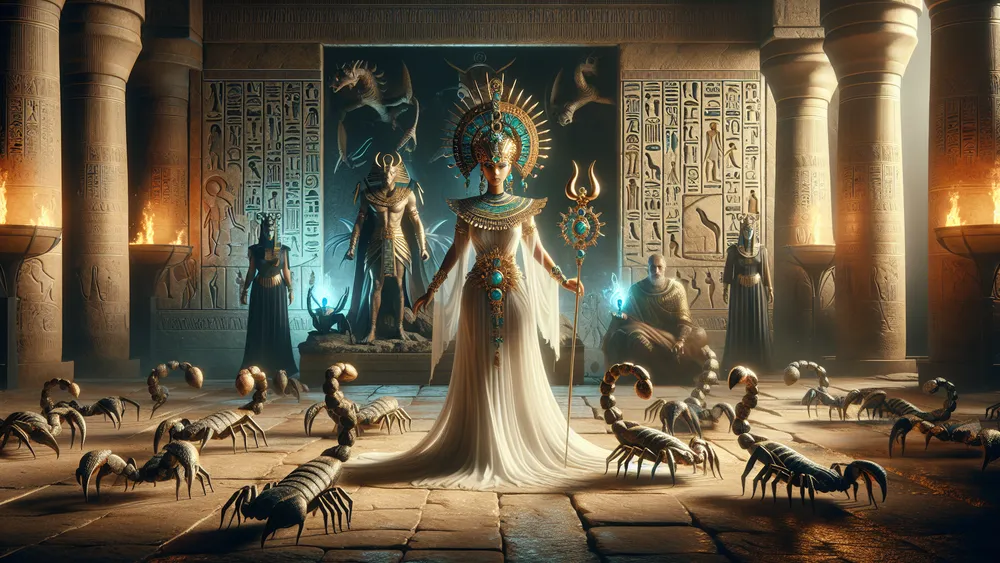
And then there is Nephthys, sister of Isis, who sometimes is linked with scorpions for her role in funeral rites and keeping the dead safe. These gods, with their ties to scorpions, show the double role of these creatures as both protectors and possible sources of harm, which show the balance of danger and safety in old Egyptian beliefs.
Scorpions in Egyptian mythology symbolize both protection and danger, reflecting the balance between safety and harm in ancient beliefs.
Scorpions in Egyptian Beliefs and Rituals
Knowing about scorpions in Egyptian mythology needs looking at how they are seen in different beliefs and rituals.
Scorpions in Funeral Spells and Texts
Scorpions appear many times in old Egyptian funeral writings, used as strong protectors for those who have died. These writings, such as the Coffin Texts and the Book of the Dead, have spells that call upon the scorpion’s guarding power to keep away bad spirits and harmful creatures that might mess up the soul’s journey to the afterlife.
Example, spells would call the goddess Serket to use her scorpions to watch over the dead, making sure they travel safely through dangerous areas of the underworld. This guarding job can be seen as a security system, where scorpions act as a warning sign against threats.
By having scorpions in these holy texts, ancient Egyptians thought they could use their two-sided nature – both feared and respected – to make a strong protectiveness for the dead, leading them safely to their final resting spot.
Scorpion Amulets and Charms
In old Egypt, they had scorpion charms and talismans used for strong symbols of protecting and healing. People made these charms from things like fayence, gold, or special stones and wore them to get the scorpion’s protective powers. Similar to today’s good luck charms, they believed these could keep away bad spirits, dangerous animals, and other risks.
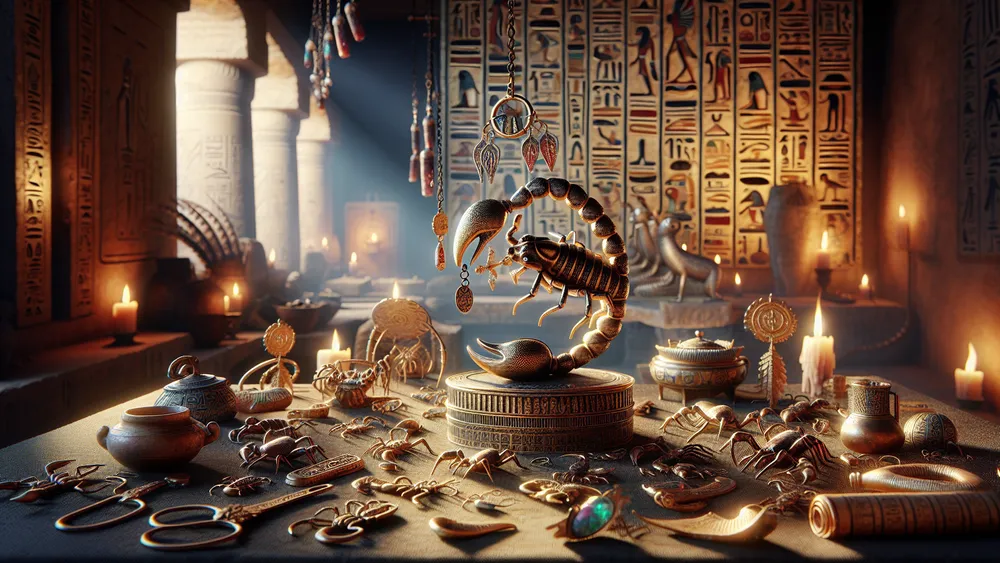
The scorpion, both feared and respected, worked well as a sign of keeping one safe and healthy. Often, these charms had spells or Serket’s name on them, making them even stronger for protecting and healing. Wearing or having a scorpion charm meant, for the old Egyptians, locking in the powerful energy of the creature to shield from danger and help with both body and soul healing.
Scorpions in Ancient Egyptian Medicine and Healing Practices
Scorpions were important not only for protection but also for medicine and healing ways in old Egypt.
Using Scorpion Venom in Ancient Medicine
In old Egyptian medicine, scorpion venom was seen as a strong thing with healing powers. Doctors and healers then thought using the venom, in the right way, could help with many health problems, a lot like how today’s medicine uses toxins carefully.
For example, they used scorpion venom in small, carefully judged amounts to ease pain and bring down swelling, similar to how we use a painkiller.
The venom could fight other poisons and might help the body heal, making it useful in old medical tools. They used scorpion venom to make a dangerous thing into a remedy that might save lives, showing how much they understood natural things and their health uses.
Healing Rituals with Scorpions
Ancient Egypt’s healing ways involving scorpions were tied to both cultural and religious activities. The goddess Serket, who controlled scorpions and their venom, was often called upon in these rituals. A healer, for example, might place a live scorpion near the sick part of the body while speaking special words to ask for Serket’s healing help. Like modern faith healing, the belief in a higher power’s help was crucial.
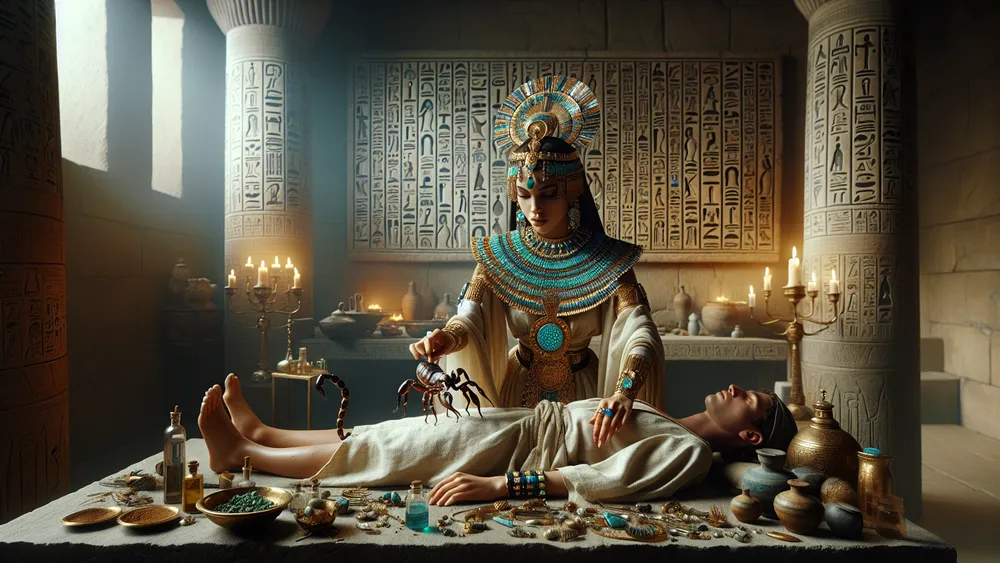
Seeing the scorpion there was thought to remove sickness and bad energies, turning them into healing power. These rituals were not only medical acts but also acts of faith, showing how the ancient Egyptians saw health, where both body and spirit care were joined.
They used scorpions in their healing methods to use the creature’s strong meaning and divine ties to bring balance and health.
Scorpions in Egyptian Stories and Modern Views
More than just in medicine and rituals, scorpions also show up a lot in Egyptian stories and still affect modern thoughts.
Scorpions in Ancient Egyptian Folktales
Old Egyptian stories often had scorpions as main figures, showing both risk and safety. For instance, there’s the tale of Isis and her seven scorpions; she is kept safe by them while going to bring back her husband, Osiris.
Each scorpion has a name and a job, representing faithfulness and nature’s protective power. Another story tells of a man, who is bad, getting stung by a scorpion, which acts as punishment from above for his wrong actions.
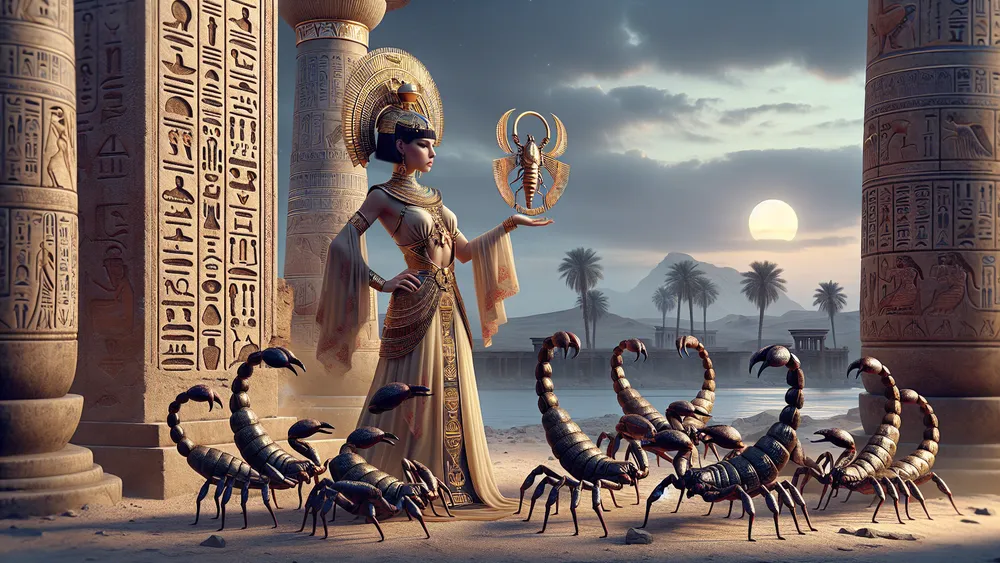
These tales taught lessons about right, protection, and scorpions’ two-sided nature as both dangerous and helpful. By using scorpions in their tales, Egyptians showed the balance between good and bad, and why it’s important to care for the natural world. These stories weren’t just for fun but were also a way to teach values and ethics to the people.
How Scorpions are Seen in Today’s Egyptian Culture
In today’s Egyptian culture, scorpions are still powerful symbols, but how they are shown has changed over time. They still show both danger and safety, but modern views often highlight their strange and unknown sides. Films, TV shows, and books today often use scorpions as symbols of tough survival.
For instance, in Egyptian movies, a person’s toughness and ability to get through hard times might be compared to a scorpion.
Also, scorpions are popular in Egyptian art and jewelry, used to show a link to ancient heritage and the natural world. These images keep the cultural meaning of scorpions alive, linking the past to now, letting new generations understand their rich, symbolic legacy.
FAQs
1. What is the significance of scorpions in Egyptian mythology?
The significance of scorpions in Egyptian mythology lies in their dual role as both protectors and symbols of danger.
2. Who is Serket and what is her role in Egyptian mythology?
Serket is the scorpion goddess in Egyptian mythology, known for her protective and healing roles.
3. How were scorpions used in ancient Egyptian medicine?
Scorpions were used in ancient Egyptian medicine primarily for their venom, which was believed to have healing properties.
4. Are there any famous myths involving scorpions in Egyptian mythology?
Yes, famous myths involving scorpions in Egyptian mythology include the story of Isis and her seven scorpions.

